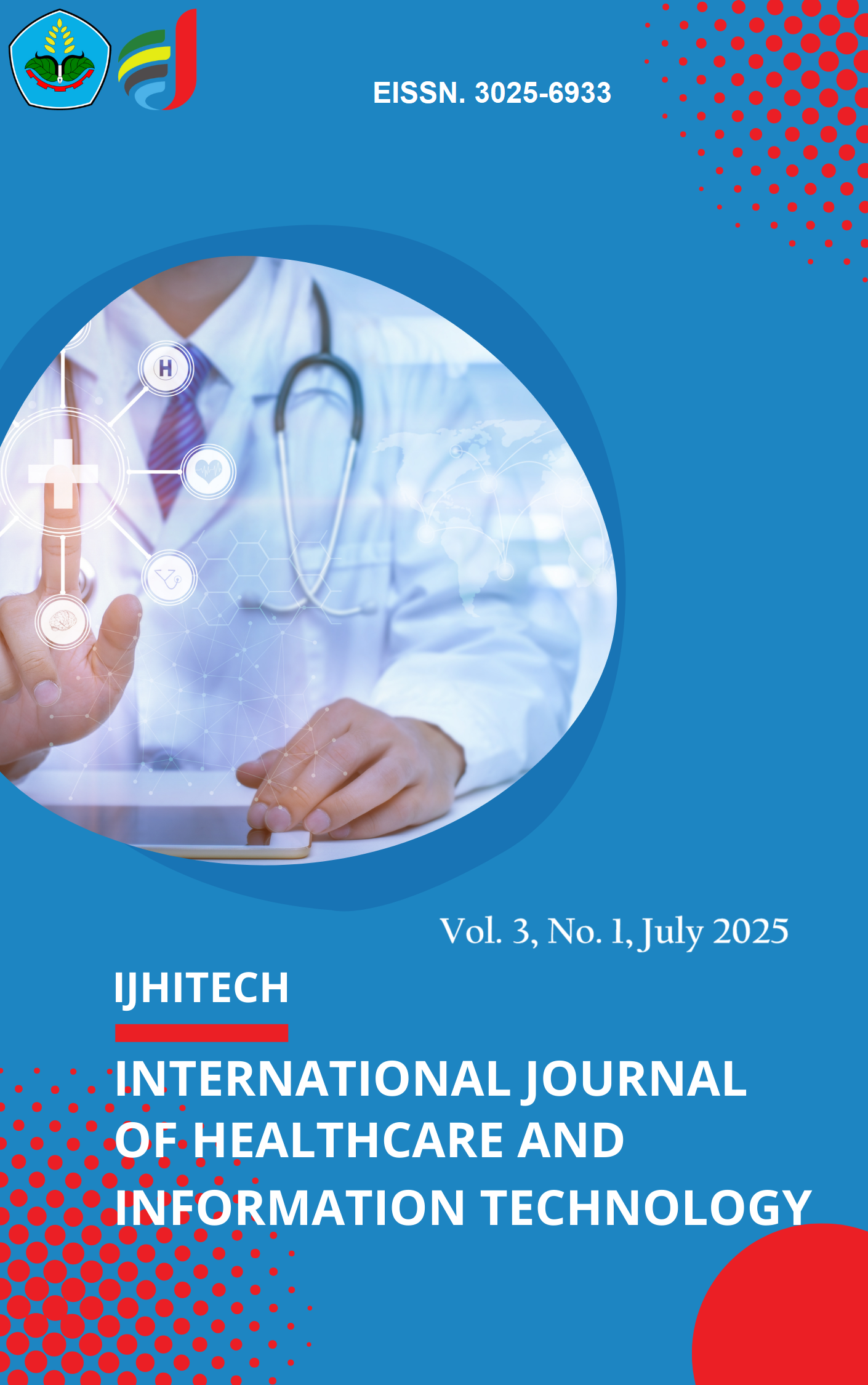Development of the E-Posyandu Kelor Gateway Based on the Continuum of Care
DOI:
https://doi.org/10.25047/ijhitech.v3i1.6157Keywords:
Stunting, e-posyandu, continuum of care,, IMR, MMRAbstract
The maternal mortality rate (MMR), infant mortality rate (IMR), and stunting rate in the Jember regency have not reached the standards set by the government. Efforts to reduce made through early detection of risk factors using the continuum of care model at to develop an e-Posyandu system. The purpose of this study was to develop an e-Posyandu information system into a “Kelor Gateway e-Posyandu” information system based on the continuum of care and equipped with a reminder system. This was a research and development study. The sample were 15 cadres from integrated service posts Manggis 15, 15A, and 18. The system was developed using the waterfall method. The results showed that the system’s development e-Posyandu based on the continuum of care reports could be automatically recapitulated and adjusted according to the manual report. This means that the cadres could send the health data reports as soft copies (PDF) or hard copies (print) to the midwives. The Kelor Gateway e-Posyandu was also equipped with a reminder system to send the integrated service posts’ acitivity schedules via SMS to pregnant women and mothers. This system has been implemented by the research subjects at their integrated service posts. and the system has facilitated the early detection of MMR, IMR, and stunting. For future studies, the Kelor Gateway e-Posyandu needs to be implemented simultaneously at all integrated service posts in the Kemuning Lor village.
References
[1] Dinas Kesehatan Provinsi Jawa Timur., “Profil Kesehtaan Dinas Kesehatan Provinsi Jawa Timur,” East Java Prov. Heal. Off., p. tabel 53, 2020, [Online]. Available: www.dinkesjatengprov.go.id
[2] M. W. Santi, M. Yunus, E. Rachmawati, and A. Deharja, “The Effect of Training on Improving the Knowledge of Cadres in Using E-Posyandu,” Proc. 2nd Int. Conf. Soc. Sci. Humanit. Public Heal. (icosh. 2021), vol. 645, no. Icoship 2021, pp. 244–248, 2022, doi: 10.2991/assehr.k.220207.041.
[3] M. W. Santi and A. Deharja, “The Effect of Information System Usability and Midwife Involvement toward Perceived Usefulness of Jember Safety Center ( JSC ) with FAI in Jember Regency,” 2nd Int. Conf. Food Technol., no. January, pp. 277–281, 2019, [Online]. Available: https://publikasi.polije.ac.id/index.php/ProceedingICOFA/article/view/1837/1167
[4] Menteri Kesehatan Republik Indonesia, “Peraturan Menteri Kesehatan Republik Indonesia Nomor 21 Tahun 202 tentnag Rencana Strategis Kementerian Kesehatan Tabun 2020-2024,” no. Table 10. pp. 4–6, 2020.
[5] Dinas Kesehatan Jawa Timur, “Profil Kesehatan Provinsi Jawa Timur,” Kementeri. Kesehat. RI, pp. 1–73, 2019, [Online]. Available: www.dinkesjatengprov.go.id
[6] Dinas Kesehatan Kabupaten Jember, “Profil Kesehatan Kabupaten Jember 2021,” 2021. https://dinkes.jemberkab.go.id/posts/profil-kesehatan-kabupaten-jember-2021
[7] Dinas Komunikasi dan Informasi Kabupaten Jember, “Profil Desa Kemuning Lor Kecamatan Arjasa,” 2020. https://ppid-desa.jemberkab.go.id/desa/kemuninglor
[8] N. A. Damayanti et al., “Integrated information system for early detection of maternal risk factors based on continuum of care approach of mother and toddler cohorts,” Healthc. Inform. Res., vol. 25, no. 3, pp. 153–160, 2019.
[9] Kemenkes Republik Indonesia, “Buletin Stunting,” Kementeri. Kesehat. RI, vol. 301, no. 5, pp. 1163–1178, 2018.
[10] N. Muna, I. Nurmawati, and E. Rachmawati, “Kie Kader Kesehatan Dan Implementasi Step-Ap Sebagai Upaya Pencegahan Stunting,” 2021.
[11] M. W. Santi, M. Yunus, E. Rachmawati, and A. Deharja, “Pengembangan dan Implementasi E-Posyandu dalam Deteksi Dini Faktor Risiko Kematian Ibu, Bayi dan Stunting,” J. Aisyah J. Ilmu Kesehat., vol. 7, no. 1, pp. 1–16, 2022, doi: 10.30604/jika.v7i1.653.
[12] N. Muna, E. Rachmawati, and I. Nurmawati, “Design of Nutritional Status System for Stunting Early Prevention,” in The First International Conference on Social Science, Humanity, and Public Health (ICOSHIP 2020), 2021, pp. 140–144.
[13] I. Nurmawati, E. Rachmawati, and N. Muna, “Gender Equality Practices: Comparison of Eating Habits in Families With Normal Nutrition, Malnutrition, and Stunting Toddler,” in 2nd International Conference on Social Science, Humanity and Public Health (ICOSHIP 2021), 2022, pp. 192–196.
[14] A. Chamid, M. W. Santi, E. Rachmawati, and M. Yunus, “Evaluasi Penggunaan Sistem E-Posyandu dengan Metode Technology Acceptance Model (TAM) di Posyandu Manggis 15, 15A, dan 18 Dusun Darungan Jember,” vol. 13, no. 5, pp. 1105–1112, 2022.
[15] E. Rachmawati, T. D. Puspitasari, M. W. Santi, and D. Lestari, “POSTING KITA (Posyandu Anti Stunting Berbasis Kolaborasi Teknologi Informasi E-Posyandu dan Asuhan Gizi Balita),” Sejag. J. Pengabdi. Masy., vol. 1, no. 2, pp. 28–34, 2024, doi: 10.25047/sejagat.v1i2.5223.
Downloads
Published
How to Cite
Issue
Section
License
Copyright (c) 2025 Ervina Rachmawati, Trismayanti Dwi Puspitasari, Maya Weka Santi, Muhammad Yunus

This work is licensed under a Creative Commons Attribution-ShareAlike 4.0 International License.




